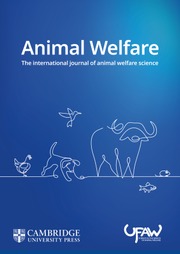Article contents
Can biomarkers of biological age be used to assess cumulative lifetime experience?
Published online by Cambridge University Press: 01 January 2023
Abstract
Objective methods for assessing the cumulative lifetime experience of non-human animals would be valuable. We develop the hypothesis that biological age is a common currency that integrates the overall quality of an animal's lifetime experience across a range of types of exposure. Ageing is the result of the accumulation of somatic damage, and its rate is determined by the balance between experiences that cause damage and experiences that mitigate damage or promote repair. Negative affective states are associated with somatic damage via both direct causal and indirect pathways. Based on these premises, we predict that individuals that are biologically old for their chronological age will, on average, have experienced worse lives than individuals that are biologically younger, both in terms of their overall health and affective experience. Biological age is, thus, an attractive measure of cumulative experience because it requires no subjective decisions either about how a given exposure impacts an animal, or about how different dimensions of welfare should be weighted in an overall assessment. Biological age can be measured objectively using biomarkers. We argue that two biomarkers, namely leukocyte telomere length and hippocampal volume, are valid biomarkers of cumulative experience in humans, with potential for use in non-human vertebrates. We discuss how these biomarkers could be used to assess cumulative experience in animals, highlighting some of the limitations. We conclude that biomarkers of biological age offer a viable objective solution to the assessment of cumulative experience and their application in an animal welfare context deserves further exploration.
- Type
- Articles
- Information
- Creative Commons
- This is an Open Access article, distributed under the terms of the Creative Commons Attribution licence (https://creativecommons.org/licenses/by/4.0/), which permits unrestricted re-use, distribution, and reproduction in any medium, provided the original work is properly cited.
- Copyright
- © The Author(s), 2023. Published by Cambridge University Press on behalf of The Universities Federation for Animal Welfare
References
- 22
- Cited by


